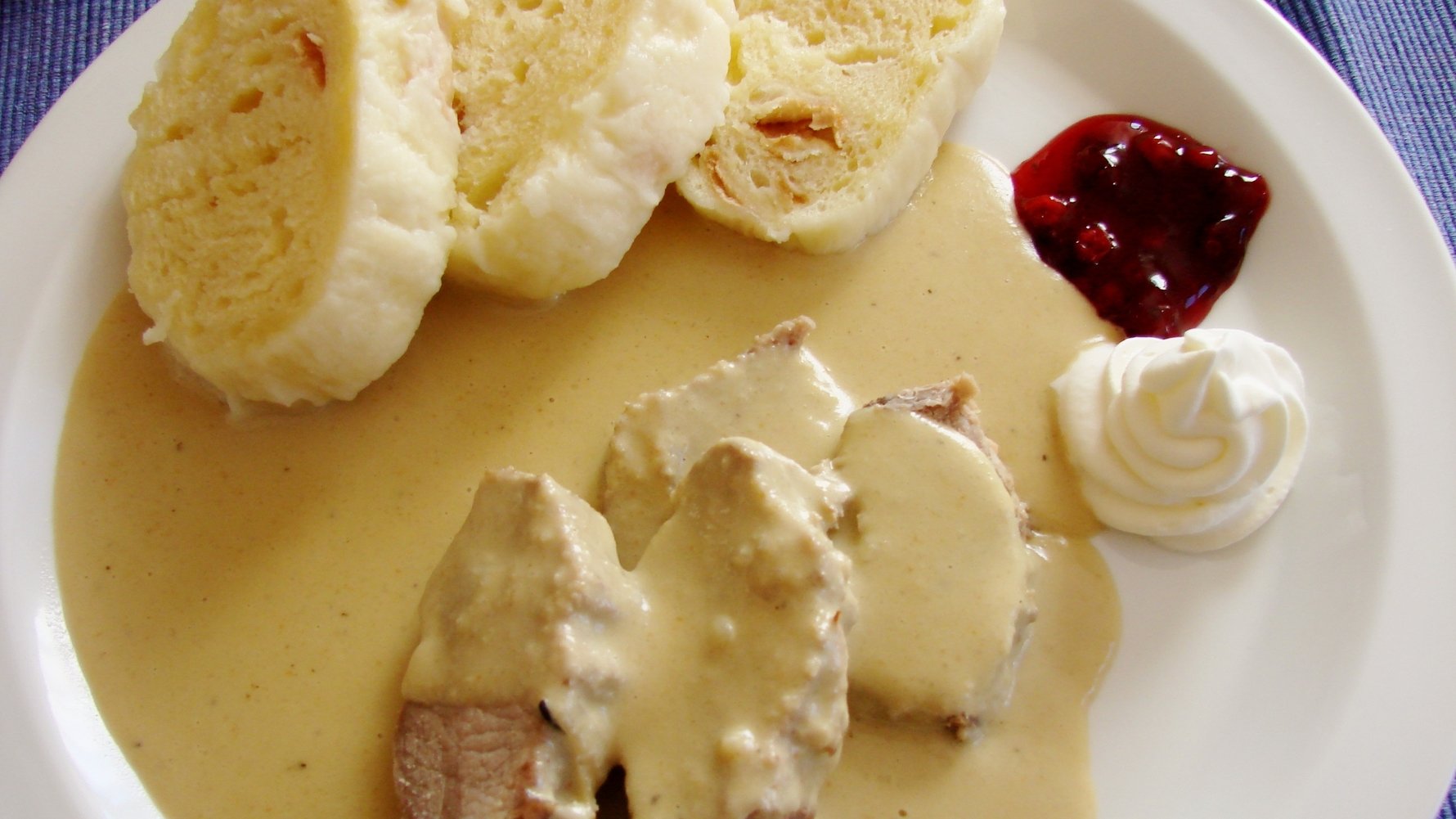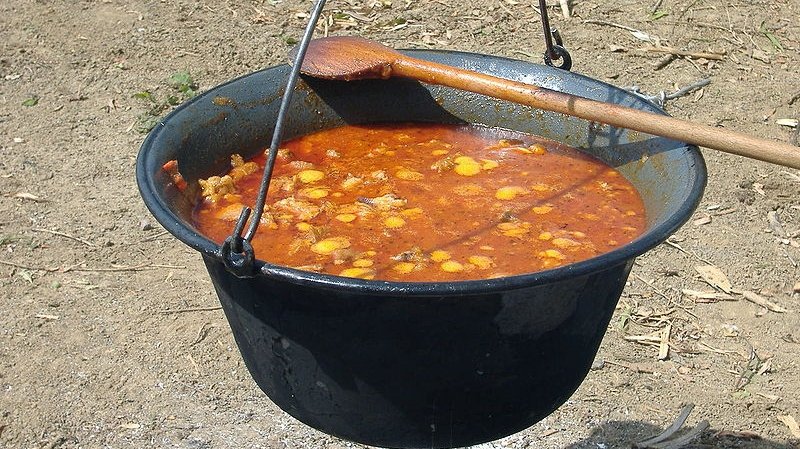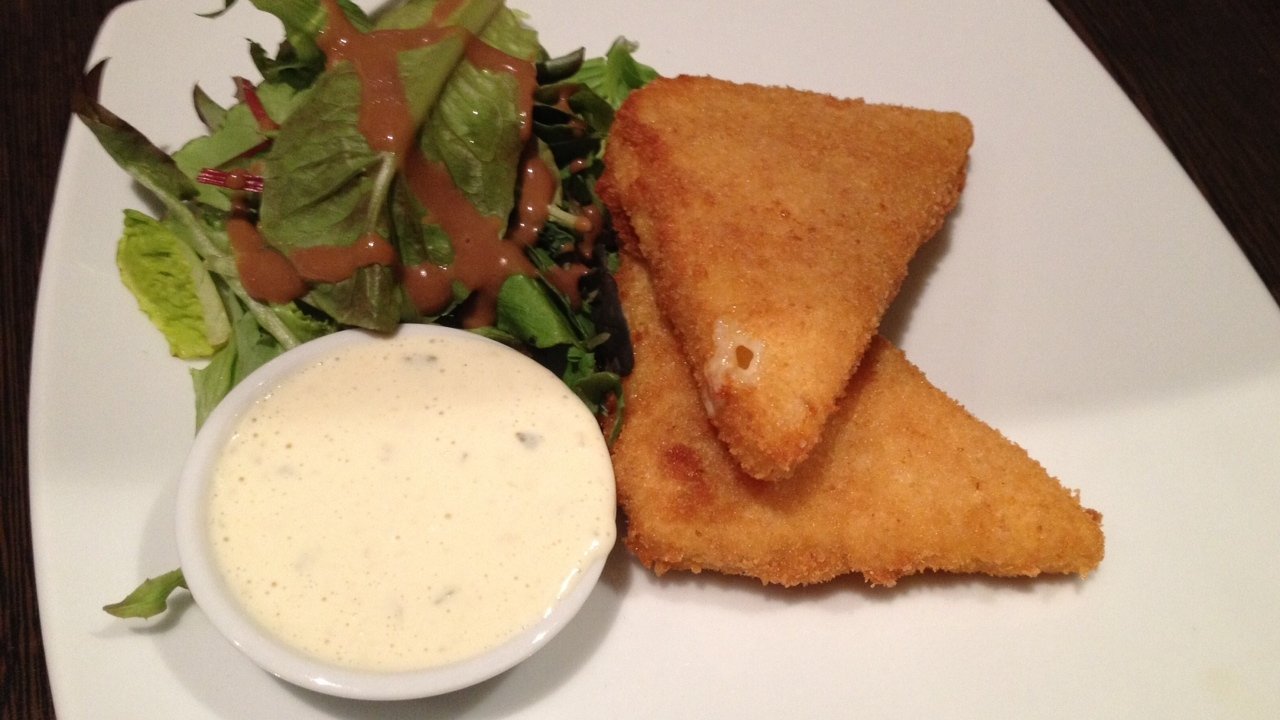Think hearty meals designed to get you through long cold winters, heavy on meat and starch, sure, but when done right, it's all "flavourfully filling" rather than just stodgy. Trust me, there's way more to discover than just beer and dumplings.
I'll walk you through everything from centuries-old traditional dishes to modern Czech cooking, plus share some useful restaurant phrases so you don't accidentally order "vepřové koleno" (pig's knees) when you want an apple strudel!
What is traditional Czech food?
Czech cuisine is comfort food at its finest. Born from the country's agricultural heritage and shaped by its Central European neighbors, Czech food doesn't try to be fancy, it aims to satisfy.
What makes Czech cuisine stand out? It's honest food with robust flavors that don't hide behind complicated spice blends or fancy techniques. Unlike some of its neighbors who go heavy on the paprika or herbs, Czech cooking lets quality ingredients speak for themselves. It's like that friend who doesn't say much but when they do, it's worth listening to.
Staple ingredients you'll see everywhere:
- Pork (seriously, Czechs love their pork)
- Beef (especially for slow cooking)
- Root veggies (potatoes are practically a food group here)
- Cabbage and sauerkraut (the tangy backbone of many dishes)
- Wheat and rye flour (for those famous dumplings)
- Mushrooms (both cultivated and wild-foraged varieties)
- Fresh herbs like marjoram, caraway seeds, and dill (subtle but essential)
What is the national dish of Czechia?
If Czech cuisine were a royal family, Svíčková na smetaně (beef sirloin in cream sauce) would wear the crown. This showstopper features tender marinated beef topped with a velvety sauce made from pureed root vegetables and cream. But wait, there's more! It comes garnished with a dollop of cranberry sauce, a slice of lemon, and a swirl of whipped cream. Sound weird? It works, I promise.
The whole thing comes with knedlíky (bread dumplings) that are perfect for soaking up every last drop of that amazing sauce. As locals will tell you, it's probably the most often named "traditional" Czech dish, you can try an excellent version at Kozlovna Apropos, where it's proudly featured on their main menu.

While Svíčková gets the official title, two other contenders fight for the throne:
Vepřo knedlo zelo (roast pork with dumplings and sauerkraut) is the holy trinity of Czech cuisine. Nothing fancy here, just well-executed roast pork alongside bread dumplings and tangy sauerkraut. The magic happens when you get a perfect bite with all three elements. The sauerkraut cuts through the richness of the pork, creating that balance that makes you want another plateful even when you're stuffed.
Fair warning: it's not the most photogenic dish on the menu (in fact, it's fairly unappetizing-looking), but it's surprisingly flavorful with lots of gravy to soak those bread dumplings in. It's a bit old-fashioned, so not every restaurant serves it, but Století is known for a solid version.
Guláš isn't just Hungary's thing! Czech-style goulash is thicker and more robust than its Hungarian cousin. Instead of serving it with noodles, Czechs pair their goulash with (you guessed it) bread dumplings. The meat simmers until it practically falls apart, swimming in a rich sauce that's fragrant with paprika. It's the kind of dish that ruins your shirt but makes your soul happy. This Czech staple varies wildly from place to place, if you want to try something special, head to Bredovský dvůr, where they make theirs with chunks of beef, spicy sausage, and potato pancakes instead of the usual dumplings.

Traditional Czech main dishes
Beyond the national all-stars, Czech cuisine offers plenty of other mouthwatering options:
- Řízek (schnitzel): Yeah, the Austrians made it famous, but don't tell Czechs that. Their version features pork or chicken pounded thin, breaded, and fried to golden perfection. It's often massive enough to hang over the edges of your plate and comes with potato salad that's way better than it sounds. Perfect pub food after a few beers.
- Smažený sýr (fried cheese): Forget mozzarella sticks, this is the ultimate cheese indulgence. A thick slab of Edam cheese gets the breaded-and-fried treatment, resulting in a crispy exterior with a molten, gooey center. It's usually served with tartar sauce and fries (or "hranolky" as they're called here). Vegetarians, you'll see this everywhere, and yes, it counts as dinner. Lokál fries up a particularly tasty version. And if you're feeling adventurous after a night out, try it burger-style (served on a bun with mayo) at one of the late-night food stands on Wenceslas Square.
- Bramboráky (potato pancakes): These aren't your delicate breakfast pancakes. Grated potatoes mix with garlic, marjoram, and caraway before hitting the pan for a crispy-outside, soft-inside result. Some places serve them as a side, others as a main. Either way, they're addictive.
- Španělský ptáček (Spanish bird): The name's a total lie, there's no bird and nothing Spanish about it! Instead, you get beef rolls stuffed with pickle, egg, bacon, and sausage. Why the misleading name? Who knows, but it tastes too good to care.
- Uzené (smoked meat): Czechs excel at smoking meats, particularly pork. The process infuses deep flavor that pairs perfectly with bread dumplings and either sauerkraut or spinach. Simple but spectacular.
And if you're just looking for something unusual to nibble on with your beer, Czech pubs have you covered:
- Utopenci (literally "drowning man"): These short, fat sausages have been "drowning" in oil, vinegar, and spices for who knows how long. Served with chopped onions and bread, they're the perfect beer snack. You can try these with a draft Pilsner at Hybernia.
- Nakládaný hermelín: Here's one for the vegetarians! This is a camembert-like soft cheese that's been pickled in oil, garlic, peppers, and spices. Also served with onions and bread, it pairs beautifully with a cold beer. Hybernia serves this one too.
Traditional Czech desserts
Got a sweet tooth? Czech desserts won't disappoint:
- Trdelník: Let's get something straight: this chimney cake isn't as traditionally Czech as tourist shops claim. But that doesn't make watching dough spiral around a cylinder over open flames any less hypnotic, or the cinnamon-sugar result any less delicious. Go ahead, be a tourist. It's worth it.
- Koláče: These round pastries with their distinctive dollop of filling in the center are the real deal. Sweet dough cradles fillings like poppy seed, plum jam, cheese, or almond paste. They're basically edible art and taste even better than they look.
- Palačinky: Think crepes, but with Czech flair. These thin pancakes come filled with jam, fruit, chocolate, or cheese, then folded or rolled. They're what pancakes dream of becoming when they grow up.
- Buchty: Imagine the perfect dinner roll, but sweet, filled with jam, and dusted with powdered sugar. These pillowy yeast buns are what childhood memories are made of. Best straight from the oven, but good luck finding any that aren't already claimed by locals.
- Medovník: Patience creates this honey cake masterpiece. Multiple thin layers alternate with sweet cream filling, then the whole thing rests for days. The waiting is torture but necessary, during this time, the cake transforms into something magical as the layers soften and flavors meld.
- Ovocné knedlíky: Fruit dumplings are a Czech phenomenon that blurs the line between main course and dessert. A whole fruit (often plums or strawberries) gets wrapped in potato or quark cheese dough, boiled, and topped with melted butter, sugar, and sometimes poppy seeds. Strange but wonderful. These aren't actually that easy to find, as most places only offer them seasonally when fruits like strawberries, apricots, or plums are abundant. If you spot them on a menu, snap them up, they're a true Czech delicacy!
Can you find vegetarian food in Czechia?
Let's be honest, traditional Czech cuisine loves meat. But don't worry, vegetarians! You won't starve in Prague.
Some traditional vegetarian-friendly Czech options include:
- Smažený sýr: That glorious fried cheese I mentioned earlier? Total vegetarian staple.
- Bramboráky: Those potato pancakes are naturally meat-free and hearty enough to satisfy.
- Houbový kuba: This Christmas Eve dish of barley and mushrooms is earthy, garlicky, and completely vegetarian.
- Ovocné knedlíky: Fruit dumplings can absolutely be a meal. No need to wait for dessert.

When dining out, look for the "bez masa" (without meat) section on menus. This isn't universal yet, but it's becoming more common, especially in touristy areas. More and more restaurants now mark vegetarian items with a leaf symbol or "V" notation too.
One word of caution though, Czech logic around "without meat" can be a bit fuzzy. Sometimes dishes with meat in them end up in this section because the meat isn't considered the main component. Always double-check with your server when in doubt.
And this might surprise you, Prague has a growing veggie scene! You'll find plenty of vegetarian and vegan restaurants serving both Czech-inspired dishes and international cuisine. The city's not stuck in its meat-loving past.
What is modern Czech cuisine?
Czech food is having a moment right now. A new generation of chefs is dusting off grandma's recipes and giving them fresh life:
- Back to roots movement: Young Czech chefs are digging through old cookbooks and rediscovering forgotten ingredients and techniques. It's like culinary archaeology with delicious results.
- Lighter interpretations: Let's face it, traditional Czech food can sit in your stomach like a brick. Modern chefs are creating lighter versions that keep the flavor but won't put you in a food coma.
- Seasonal and local focus: Farm-to-table isn't just a buzzword in Czech restaurants, it's becoming standard practice. Menus change with the seasons, showcasing the best of what local farmers and producers have to offer.
- Fine dining makeovers: Those humble dishes your Czech grandma made? They're now getting the white-tablecloth treatment. High-end restaurants are elevating peasant food to art form.
- Global influences: Czech chefs aren't cooking in isolation anymore. They're bringing techniques and flavors from around the world to create exciting fusion dishes that respect Czech traditions while pushing boundaries.
If you're curious about modern Czech cuisine, check out restaurants like Nota Bene, Field, Eska, and La Degustation Bohême Bourgeoise in Prague. They're earning international recognition (including Michelin stars) for their innovative approaches to Czech flavors.
Czech beer and drinks: what to pair with your meal
You can't talk about Czech food without talking about beer. Czechs drink more beer per person than anyone else in the world. It's not just a beverage here, it's practically a special experience:
- Pilsner (světlý ležák): This is the beer that launched a thousand imitators. Golden, crisp, with just the right amount of bitterness, the original Pilsner Urquell from Plzeň (1842) created a style that now dominates global beer production. It's perfect with hearty dishes like goulash or pork.
- Dark lager (tmavý ležák): With notes of caramel, coffee, and chocolate, dark Czech beers have more complexity but remain surprisingly drinkable. They pair beautifully with rich dishes and even desserts.
- Tankové pivo (tank beer): Want to taste beer at its absolute freshest? Look for places serving tank beer. It's unpasteurized and delivered directly to restaurants in temperature-controlled tanks, resulting in exceptional flavor and a smooth, creamy texture. Beer nerds, seek this out.
But there's more to Czech drinks than just beer:
- Becherovka: This herbal bitter has a distinctive ginger and cinnamon profile that makes it the perfect after-dinner digestif. Some call it "Christmas in a bottle."
- Slivovice: Proceed with caution! This plum brandy packs a serious punch. It's especially popular in Moravia, where many families make their own. A small glass goes a long way.
- Burčák: If you visit during early autumn, don't miss this young wine. Still in the fermentation process, it's slightly cloudy, sweet-tart, and naturally fizzy. It drinks easy but can sneak up on you—locals joke it's "still working" in your stomach.
- Kofola: Not drinking alcohol? Try this Communist-era alternative to Coca-Cola. With a distinctive herbal flavor, many Czechs prefer it to international sodas. It's an acquired taste but worth trying for the cultural experience.
Words to know when going to a restaurant in Czechia
The Czech language is notoriously difficult for foreign tongues, those unusual letters and heavy declensions will tie your tongue in knots. But a few key phrases will make your Czech dining experience much smoother:
| Category | Czech | English |
|---|---|---|
| Restaurant vocabulary | Restaurace | Restaurant |
| Jídelní lístek | Menu (food menu) | |
| Nápojový lístek | Drinks menu | |
| Vinný lístek | Wine list | |
| Účet, prosím | Bill, please | |
| Na zdraví | Cheers (literally "to health") | |
| Dobrou chuť | Enjoy your meal | |
| Děkuji | Thank you (day-koo-yi) | |
| Menu terms | Předkrmy | Appetizers |
| Polévky | Soups | |
| Hlavní jídla | Main courses | |
| Přílohy | Side dishes | |
| Dezerty | Desserts | |
| Nápoje | Beverages | |
| Oběd | Lunch | |
| Večeře | Dinner | |
| Snídaně | Breakfast | |
| Food terms | Hovězí | Beef |
| Vepřové | Pork | |
| Kuře | Chicken | |
| Ryba | Fish | |
| Sýr | Cheese | |
| Zelenina | Vegetables | |
| Ovoce | Fruit | |
| Knedlíky | Dumplings | |
| Brambor | Potato | |
| Hranolky | French fries | |
| Rýže | Rice | |
| Cooking methods | Smažené | Fried |
| Pečené | Baked | |
| Vařené | Boiled | |
| Grilované | Grilled | |
| Na roštu | Roasted | |
| Dušené | Steamed | |
| Dietary requests | Bez lepku | Gluten-free |
| Bez masa | Without meat | |
| Vegetariánský | Vegetarian | |
| Veganský | Vegan | |
| Jsem alergický/á na... | I am allergic to... |
Don't worry about perfect pronunciation. Most Czechs appreciate any effort to speak their language, and in tourist areas, English menus are common. A smile and pointing work wonders too!
A couple notes on ordering:
- When staff bring you a menu, they'll often immediately ask what you want to drink. If you know, great, if not, just say you need to look at the menu first.
- Sides don't typically come automatically with most dishes. You'll need to order your main plus your choice of potato or other side, which can be found in the přílohy (side dishes) section of the menu. Most dishes have a typical side that goes with them (like smažený sýr and chips). When in doubt, ask your server which combination works best.
- When it's time to pay, the server will bring your bill and wait for you to pay immediately. Don't leave your tip on the table,hand it directly to the server when you pay.
Where to eat authentic Czech food in Prague
Prague offers amazing spots to try Czech cuisine, from historic beer halls to Michelin-starred innovators:
Traditional pubs (hospody):
- U Fleků - Operating since 1499 (not a typo!), this historic brewery and restaurant serves a dark beer you can't get anywhere else. The atmosphere alone—think dark wood, stained glass, and communal tables—is worth the visit.
- Lokál - This modern chain has revolutionized Czech pub food by focusing on perfectly kept tank beer and traditional dishes made with high-quality ingredients. Their řízek (schnitzel) is consistently voted the city's best.
- U Pinkasů - One of the first pubs to serve Pilsner Urquell back in 1843. Hidden in a former monastery near Wenceslas Square, its secluded beer garden is a perfect escape from summer heat.
Mid-range restaurants:
- Café Louvre - This historic café serves excellent traditional Czech dishes in an elegant setting. Their svíčková is textbook perfect.
- U Modré Kachničky - The name means "At the Blue Duckling," and duck is indeed their specialty. The charming interior feels like dining in a fairy tale cottage.
- Hostinec U Kocoura - This hidden gem in Malá Strana serves authentic Czech food without the tourist markup. It's where locals go when they want traditional food without fuss.
Fine dining experiences:
- La Degustation Bohême Bourgeoise - This Michelin-starred restaurant offers modern interpretations of 19th-century Czech recipes, served as a tasting menu. Splurge-worthy.
- Field - Another Michelin star holder focusing on Czech-inspired seasonal cuisine. Their innovative approach respects tradition while creating something entirely new.
- Eska - Located in a converted factory in hip Karlín, Eska focuses on traditional techniques like fermentation paired with modern presentation. Their sourdough bread alone is worth the trip.
Pro tip: Visit during lunch hours (typically 11:30 AM to 2:00 PM) when many restaurants offer daily lunch specials called "polední menu" at significantly reduced prices. Same great food, smaller hit to your wallet.
What to expect from Czech cuisine
Czech food isn't as internationally famous as Italian or French cuisine, but that's part of its charm. It's unpretentious, hearty, and deeply satisfying, like getting a hug from your grandmother, if your grandmother was really good at roasting meat.
What you'll find in Czech cuisine:
- Giant portions that'll have you loosening your belt
- Rich, comforting flavors that hit the spot after walking Prague's cobblestone streets all day
- Incredible value compared to Western European destinations
- Beer so good it'll ruin other beers for you
- A cuisine in transition as tradition meets innovation
Look, some dishes might seem strange at first. Fruit with meat? Whipped cream on a savory dish? But that's half the fun of traveling, discovering flavor combinations you'd never imagine work until you try them.
So grab a seat at a centuries-old pub, order something you can't pronounce, and raise a glass of liquid gold to Czech cuisine. Na zdraví! Your taste buds are in for quite an adventure.




Comments